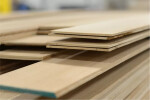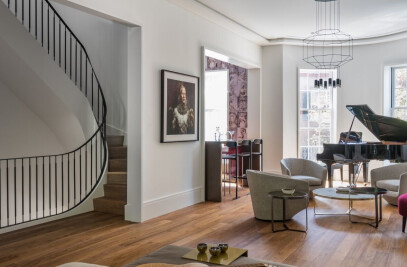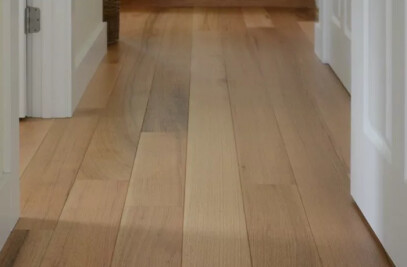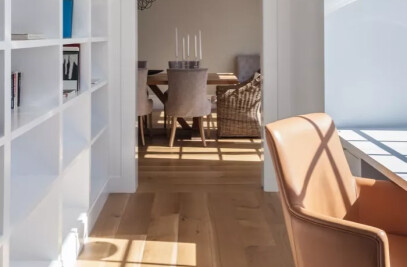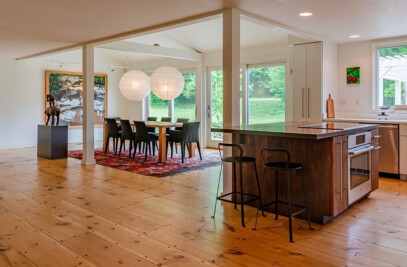Vermont Plank Flooring takes the recipe for engineered wood flooring and dramatically improves upon it. The company fuses the highest quality materials and then stir in the most advanced technologies to create wide plank engineered flooring that is far superior to the industry standard.
By slicing hardwood into thin plies, and then restacking with the grain running in alternate directions, an incredibly strong and stable structure is created. Top that with a layer of chosen locally sourced hardwood (or premium pine) species, and the results is flooring that is as beautiful as it is sturdy.

Humidity
Engineered flooring is not recommended if the relative humidity (RH) drops below 35%. Engineered flooring is made from living, breathing, solid wood, and it is not indestructible. If the RH in your home drops below 35%, the solid wood top layer of the engineered plank can check or crack as it contracts while the plywood substrate maintains its original shape.
During the winter months in the northeast, for example, it is not uncommon to see relative humidity well below 20%. To avoid excessive dryness, moisture must be added to your indoor environment to bring the humidity level above 35%.

Constructed 100 percent in-house at a Vermont Mill
Engineered wood planks are made of thin lamella of hardwood, glued on top of a plywood base. In Vermont Plank Flooring's lamella room, the 22-millimeter thick planks are passed through a band saw, which peels a 6.4-millimeter thick slice from the top side of the board with each pass. Two passes result in three identically thick lamellas, with 1.4 millimeters lost to the thickness of the blade itself on each pass. The lamellas are then fed through a brush machine to clean the surfaces.

Meanwhile, the adjacent beam saw rips a 4-foot by 8-foot sheet of the highest quality 15-millimeter-thick cabinet-grade plywood into planks that match the width of the lamellas, up to 12 inches maximum. The beam saw does this with incredible efficiency, making up to four cuts simultaneously on each plywood sheet.
The freshly cut plywood planks and lamellas are then brought to the glue applicator where hot melt glue, heated to 295°F, is sprayed evenly on the plywood. The lamellas are then glued down to the plywood and passed through a five-roller press exerting 1,000 pounds of force per square inch to assure an incorruptible bond. To confirm the quality of that bond, samples are cut and alternately soaked in water and heated in ovens for various lengths of time, with multiple checks for adhesion failure throughout the process.
After passing this quality check, the planks are cut to length by a flying saw, and lastly, sent through the molder where the lamella (or wear layer) is planed to five millimeters resulting in an overall plank thickness of 3/4 of an inch. The tongue and groove is also milled along the long sides and then the planks are passed through the end matcher where the ends receive the tongue and groove.
Collapse
To a traditionalist, engineered hardwood flooring may seem objectionable. The term “engineered” implies it was designed and constructed, as opposed to having simply grown in the woods, fueled by sunshine, soil, and rain.
And in many cases, that traditionalist makes a good argument. Unadulterated solid wood is beautiful and sturdy and pure. But it has limitations.
Solid wood, as a formerly living entity, continues to react to its environment, most noticeably by expanding and contracting due to changes in temperature and humidity, and by warping, buckling, or splitting if it is in prolonged contact with excessive wetness.
As such, in locations that regularly confront moisture, the stability of engineered planks is recommended to combat movement and degradation. And one doesn’t have to live in a rainforest to encounter excessive moisture.
Planks laid in bathrooms, laundry rooms, below grade in basement rooms, or anywhere when laid directly on concrete, all have the potential for degradation due to moisture, even in relatively dry climates.
Collapse
No matter what engineered hardwood flooring one buys, it will contain a top “wear” layer, backed by a number of layers of plywood core material. The wear layer, which you will see and walk directly on each day is, in most engineered flooring products, generally a one-to-three millimeter-thick lamella of hardwood.
Vermont Plank Flooring insists on a five-millimeter lamella, and it mills that lamella from the same high-quality, sustainably harvested trees that produce our solid hardwood planks. This thickness and quality relate directly to the lifespan of the floor. The thicker and higher grade the wear layer, the more times the flooring has the potential for sanding and refinishing.
While refinishing a hardwood floor is not something one does often (the average floor is refinished every 15-20 years), it’s nice to know that a floor has the potential for rejuvenation if it is showing a lot of wear.
With a 5-millimeter wear layer, one has the capability of performing four to six sandings and refinishings, ultimately providing for a 60- to 120-year lifespan for your floor. Thinner lamellas will allow for fewer refinishings and, as a result, will need replacement sooner.
The core
Below the wear layer is the core. While most manufacturers utilize thin layers of plywood for the core, their products vary in how many layers, and in the quality of those layers. Anywhere from three to nine layers of plywood is the industry standard, but at Vermont Plank Flooring, we use 11 layers.
Most manufacturers use regular-grade plywood, which typically includes layers with flaws and voids. But Vermont Plank Flooring insists on the highest-quality cabinet-grade plywood. These solid void-free veneer layers are 1.5-millimeters thick and cross-banded, making a flatter, more balanced, and highly stable sheet.
All of these layers are glued together. Most manufacturers rely on formaldehyde-based glues, which are strong, but they off-gas potentially harmful fumes. Vermont Plank Flooring uses only formaldehyde-free adhesives.
Collapse
Great flooring, whether solid hardwood or engineered, comes from healthy and fully mature trees. Vermont Plank Flooring only works with sustainably-minded woodlot owners, often with FSC certification, who patiently allow their trees to reach full maturity and select only the healthiest ones to harvest.
That domestic hardwood lumber is brought to the family-owned facility in southern Vermont and is ripped into wide-plank boards that meet the dimensional and grading specifications of an individual client.
Those ripped planks are then moved across the facility to the Wintersteiger, which is the machine that slices the thin lamellas from the thicker planks of lumber. The lamellas are then glued to the cabinet-grade plywood backing, and the newly engineered plank is then run through the molder, which cuts the precision tongue and groove along the long edges of the plank. The end-matching saw then adds the tongue and groove to the short ends of the plank.
Engineered flooring performs optimally in internal environments with greater than 30% relative humidity. The NWFA (National Wood Flooring Association) specifies an acceptable humidity range of 30% - 55%.
Just like solid hardwood flooring, engineered flooring prefers a stable environment, in equilibrium with temperature and humidity.
In very dry environments, where the relative humidity is below 30% for an extended period of time, the wear layer on engineered flooring can check or crack as the solid wood top layer shrinks and the plywood substrate maintains its original shape. This is not a product defect, but rather the reaction of the engineered plank structure to an overly dry environment.




